Turntables, Afghanistan. MI-24
After it became clear that the army was in the midst of armed struggle and open hostilities, it was not avoided, they began to correct the situation with the most energetic methods. 1 February 1980 to the aviation unit received an order to lift restrictions on the consumption of ammunition. To enhance the air group had to attract military helicopters from other military districts. February 29 with the help of "Anteyev" transport aircraft in TurkVO redeployed a squadron of Mi-XNUMHD helicopter regiment from Rauhivka (OdVO), which immediately went to Afghanistan, beginning to operate from Bagram airport. Following to the Tajik settlement of Moscow, another helicopter squadron was sent to work in the northern regions of Afghanistan. She was stationed in Kunduz and 24. On June 27 was officially incorporated into the air force of the 1980 Army.
The Mi-24 squadron from the Transcaucasian 292 OBVP settled in Jalalabad (a year later, in the summer of 1981, the regiment replaced the newly formed 335-II OBVP). As part of the 50 th OSAP, which was formed in accordance with the directive of the USSR Ministry of Defense 4 in January 1980, based on Chirchik, it was immediately foreseen the presence of a combat helicopter squadron on the Mi-24. The first combat sortie of a regimental Mi-24D carried out 11 March 1980 from Kunduz. By the end of the month the regiment flew to Kabul, from where he worked until the end of the war, constantly having one Mi-24 squadron in it. Another combined helicopter detachment, numbering two dozen Mi-8 and Mi-24, arrived at Kunduz at the end of 1980.
In total, the 40 Army Air Force by January 1982 numbered the 251 helicopter, including the 199 "combat", as stated in the document of the Air Force Institute of State Administration (apparently, there was an inaccuracy in the terminology and all armed Mi-8 were meant and Mi-24). Nevertheless, the lack of Mi-24 remained tangible, which explains the prolonged practice of using the “eights” for shock purposes. In the absence of combat helicopters in most parts of their task, they had to solve the same Mi-8, even if not in the best way adapted for this. In the aforementioned operation to destroy the Dushman base in Rabati-Jali, in early April 1982 an entire armada of two helicopter regiments was deployed, but not a single Mi-24 was among them - they simply did not exist on the Kandahar base at that time.
Later, military helicopters supplemented the other parts of army aviation already in Afghanistan. In mid-February, the X-NUMX squadron MI-1982D was included in the Kandagar 24-th ORP. Since April, the 280 Squadron Mi-1982 became part of the 24 ORP in Kunduz. As a result, almost all parts of army aviation in the 181 Army Air Force, from regiments to individual squadrons, received Mi-40 helicopters (with the exception of only Soviet-made, transport aircraft, whose tasks were not directly involved in the fighting). .
Another, and very significant, organizational and staffing exercise was the transfer of helicopter units and subunits to reinforced wartime personnel. By the end of the summer 1980, all helicopter squadrons in Afghanistan were staffed with a train of five units of four helicopters in each - instead of the previous four. Accordingly, the squadrons numbered 20 helicopters instead of 12-16, as it was before (the number could differ both in large and in the smaller direction, according to circumstances - for example, after a loss or, conversely, recovery after an accident of “unaccounted” cars, the tail number of the downed helicopter, with an eye to the unkind mark, was never assigned to the new one). To replenish helicopter units in Afghanistan according to the new states, it was necessary to search for crews and equipment in different districts, combing literally all over the army aviation. In early August, 1980 assembled 72 helicopter crews for the Mi-8 and Mi-24 with equipment, which 16 numbers of the same month flew to Afghanistan and were distributed to the 40 Army's air forces, at a base in Kokayt.
The beginning of the combat operation of the Mi-24 was accompanied by considerable problems caused both by the lack of experience and the features of the machine itself, multiplied by the specifics of the Afghan conditions. High speed qualities and maneuverability of the Mi-24 were achieved due to the greater specific load on the rotor (it was one and a half times smaller in area than the G-8), which did not have the best effect on the landing qualities and carrying capacity. During combat maneuvering at high speeds, the “striped” with its high aerodynamic load on the propeller blades was subject to the dangerous phenomenon of “pick-up” with overload of overload and exit to disruptive modes. The unexpected behavior of the helicopter was perceived as a loss of control and insubordination of the machine.
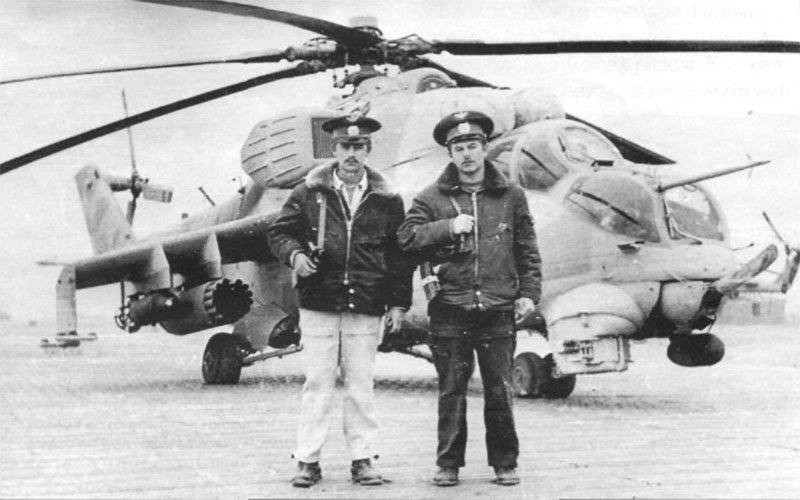
The helicopter’s drawdown was noticeable at the exit of the dive. When performing energetic maneuvers, the machine could burrow, losing height and slipping on a bend. Vigorous control during maneuvers, braking and avoidance of obstacles led to dangerous situations - lack of coordination of maneuver, hitting a difficult spatial position, screw blows on the tail with the inevitable transition to an emergency situation. In combination with the lack of power and injectivity of engines in the mountains, shear flow and “heavy” control of piloting the Mi-24 significantly complicated, which was especially noticeable compared to the lighter and “volatile” Mi-8.
Local peculiarities contributed - poor landing sites with limited approaches, flying in mountainous areas with poor conditions for maneuver, meteorological conditions with many orographic disturbances, unexpected air currents and turbulence throwing a helicopter onto the rocks. Many gorges looked like real "stone bags", with no way out, and air currents blew in different directions from the neighboring slopes - ascending from the heated by the sun and descending from remaining in the shade. In addition to the difficulties in piloting, cramped conditions and strong enough winds affected the application weapons: the pilot had very little time to assess the situation and aim, and the air flow literally “blew off” the rocket volley and carried the dropped bombs.
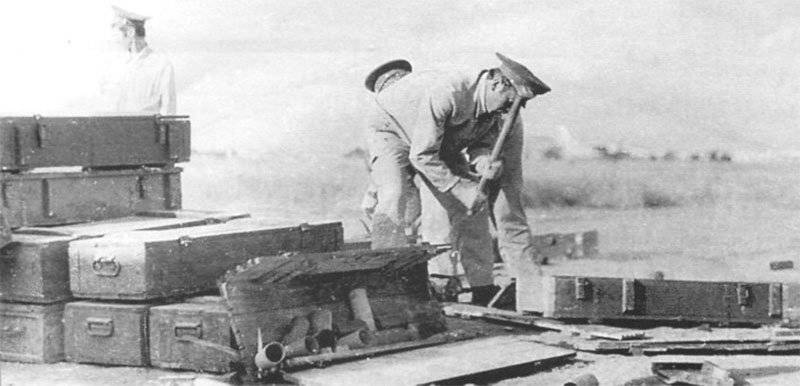
Fire training in the training crews of combat helicopters took its rightful place. Almost no one had practical combat skills in the local difficult conditions, and piloting practice in such a situation: the pilots who had arrived from the Odessa steppes had to see mountains only at a resort in Minvody. Lessons were worth considerable losses, mainly due to accidents. By the end of 1980, the 40 Army's air force 21 lost the Mi-24 helicopter (even more than the Mi-8, which had been lost to the 19). Most of them were lost not at all for military reasons and without any fire damage. In particular, in the Kunduz squadron, half of the available Mi-24s were destroyed during all kinds of flight accidents, from pilot errors to difficult conditions. In particular, in December, 1980 took off the Mi-24 with its propeller, raised a snow whirlwind and, when the pilots lost visibility, flew onto the nearby Mi-6, chopped the extreme helicopter with its blades and fell right there.
The first who died in Afghanistan was a flight engineer Mi-24 senior lieutenant A.N. Saprykin. 21 January 1980. His helicopter conducted aerial reconnaissance and came under fire. The pilot who carried out his ninth combat flight was seriously wounded and died two days later in the hospital. Three weeks later, on February 13, Jelalabad was hit by Captain S.I. Mi-24. Khruleva from the 292-th regiment, crashed with the crew. This Mi-24 was the first lost in Afghanistan, and the first combat loss of the 40 Army aviation.
At the same time, in a combat situation, the Mi-24 with its powerful armament and security had clear advantages, being a machine created and adapted specifically for percussion (although the opinion of its superiority was repeatedly challenged, and many preferred for most tasks the Mi-8MT, considering the “twenty-four” overweight and not sufficiently maneuverable in high-altitude conditions). Nevertheless, the specificity of the battlefield took its own, and gradually the share of Mi-24 increased to almost half of the helicopter fleet, and mixed Mi-8 and Mi-24 pairs complemented each other. Already in the Panjsher operation in May-June 1982, the 32 of the Mi-24 helicopter was involved - almost all that were then available. It is significant that I, with the saturation of the 40 Army's air force with G8 combat helicopters, who had previously performed “jack of all trades”, began to be involved much less frequently in performing drums, losing this role to more adapted crocodiles. Over time, the participation of the Mi-8 in aviation support for well-explained motives declined even more, and from 1985, the share of departures for such tasks did not exceed 10 — 12%. According to the pilot-navigator Mi-8, Senior Lieutenant AM Degtyarev, who arrived in 50-th OSAP in November 1985, and served there XANUMX until January, for these fifteen months “they used bombs only twice, destroyed the bridge under Asmar and operations in the Kunar Gorge, however, were bombed conscientiously, working the ten Mi-1987 and throwing four OFAB-8. Blocks were also used infrequently, the specifics of the tasks are different, most of the departures were carried by carriages, supply of posts, target designation, because of which even unnecessary farms were rented and flown without them.
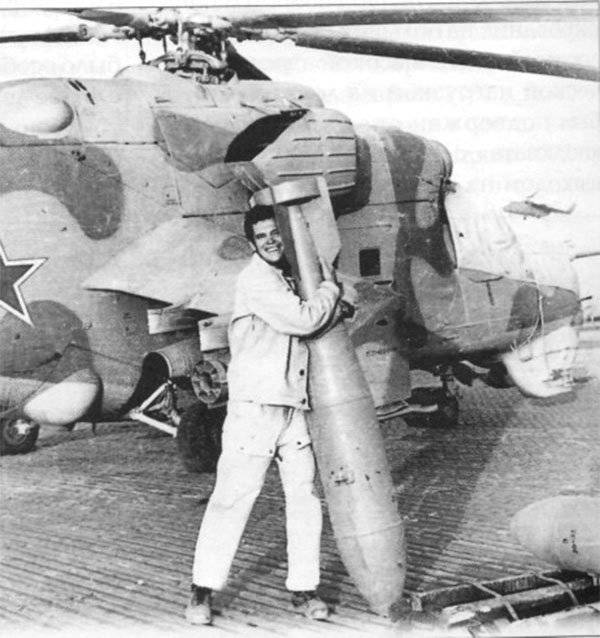
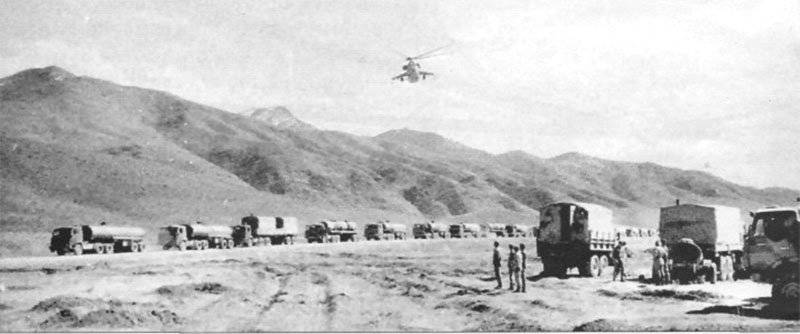
Since this practice came into play and the Mi-8 pilots in most of the sorties assigned fire cover and support to the accompanying “crocodiles”, the army commander even indicated that the equipment of the helicopters corresponded to the combat situation and those with unforeseen events did not turn out to be “unarmed ". In particular, it turned out that the helicopters involved in the “Veil” system, departing to fight the caravans, very often went “empty”, although inspection teams usually needed air support. By order of the 40 Army from 11 December, 1987 ordered the helicopters involved in reconnaissance and patrol actions to equip properly and for this purpose without fail “to designate targets, as well as defeat the firing points, Mi-8MT with equipping groups two blocks UB-32 ".
Organizational measures were, as they say, a pleasant thing and accompanied the entire course of the Afghan campaign in accordance with the changing environment. The materiel, including weapons, as its system, which determines the effectiveness of a combat helicopter, showed its features in intense combat work.
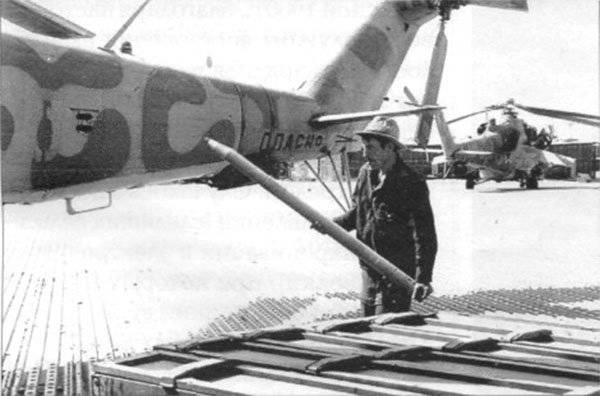
The possibilities provided for placing an assault force on the Mi-24 (at that time the concept of using a combat helicopter as a “flying BMP” was popular) was unclaimed. Like at home, in practice, this was hampered by the low bearing properties of a fairly heavy armored vehicle with a set of weapons (empty, it weighed almost 1,5 and more Mi-8). With paratroopers, the Mi-24 became sluggish, and dwarfs were more suitable for accommodating the soldiers in the cargo compartment - its height was only 1,2 m. In Afghanistan, the implementation of such designs was also hampered by a general deterioration in flight performance, especially sensitive with specific features of the Mi-24.
One of the few examples of the use of “crocodiles” in similar quality was the flight of Kunduz vehicles in the first military year: having decided to use the available opportunities, fighter shooters from the neighboring 24 airborne troops from time to time took the Mi-56 from Major Koz’s squadron assault brigade. To enhance the firepower on board, there were four soldiers each with light machine guns firing through side windows in the windows. Their presence added an extra half-ton, but during the winter months this did not have a particular impact on the helicopter’s volatility. It is unknown how far this undertaking has justified itself, however, during one of the sorties, Captain Glazyrin’s helicopter took the forced one in the mountains, and seven crew and riflemen were with it at once. To the rescue, hooked Mi-24 captain Valiakhmetova, picked up all at once. It was known only to them who were rescued in a close compartment the size of a “Zaporozhets”, but 14 people were on board with “their” rifle group. The helicopter, however, was able to perform a vertical take-off from the mountain platform and deliver all to the airfield.
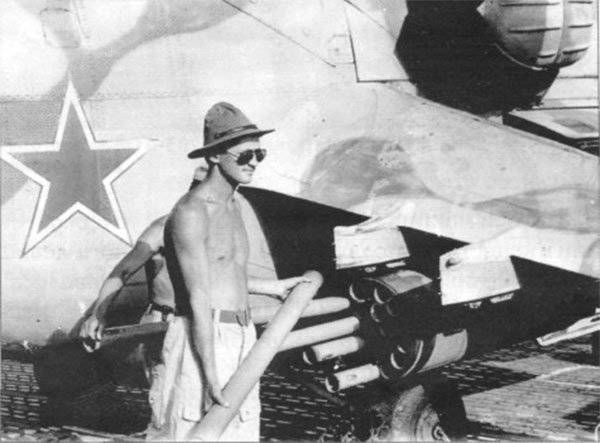
Difficult operating conditions soon revealed a number of deficiencies in the Mi-24 weapons and, above all, its USPU-24 rifle installation. The high rate of fire of the YakB-12,7 four-barreled 4000-5000 machine gun / min (for good reason, it was called “high-tempo”) and an impressive second volley of 3,6 kg (for comparison: for the AUSH with the same caliber - only 0,5 kg) were significant design complexity. The rotating block of trunks using a kinematic mechanism was set in motion by a kind of gas-powder engine, using exhaust powder gases. The machine gun fire was conducted by the pilot-operator with the help of the KPS-53AB mobile sighting station, which provided weapon guidance and firing with the necessary corrections for speed, angular displacement and others required for aiming (the station in the operator’s cabin was curiously called “stern”, keeping the letter "K" in the name of the prototype, borrowed from long-range bombers). The pilot could also fire, but only when the machine gun was installed in the forward position along the axis of the vehicle and used as a stationary, aiming at its ASP-17B sight (on the Mi-24B, on the previous Mi-24D they used a sight simpler - PKV type) .
The machine gun was rightfully considered a formidable weapon - its impressive volley had a powerful striking effect both in manpower and in vehicles in caravans of Dushman, carrying even a two-meter thick duval, impenetrable to the C-5 missiles. In normal operation, the machine gun deserved the most positive feedback from the pilots. Andrei Maslov, who flew as an operator for the Mi-24В in the 50 regiment, described his impressions of working with a machine gun in the following way: “His rate of fire is such that the car cuts in half. Armor-piercing incendiary bullets even break through the armored personnel carrier, take your turn - and a swarm of red fireflies flies away into the distance, even during the day you can clearly see it. God forbid to fall under his turn - only hands and legs fly from a man. It beats exactly, we somehow ran into the “bearded” on a little hill, I noticed the “spirit” sitting at the entrance to the cave and managed to get ahead, shot at it offhand. The queue went right through it, and then I did not see the sand fountains, and the whole cave was boiling from dust. When you enter the combat course, the target shakes in the crosshairs of the sight and after pressing the trigger in the cockpit it smells of powder powder, for some reason the films about the war come to mind and it seems that it is not with you, but with someone else ... "
At the same time, the YakB-12,7, with its rather complicated device, turned out to be sensitive to overheating and pollution — everyday satellites of combat work. In a gas engine, powder was deposited, the system worked at the limit on temperature and knot resistance, which was known before (with 1470 ammunition ammunition, the instruction limited the 400 maximum to shots "with subsequent interruptions to cool the weapon for 15-20 minutes", Otherwise, the heating threatened to explode with primers and cartridges. At home, where shooting practice was infrequent, and the cartridges were read out, these shortcomings did not become a problem, but in a combat situation, where they exceeded all standards, the YakB-12,7 became a source of incessant reclamations.
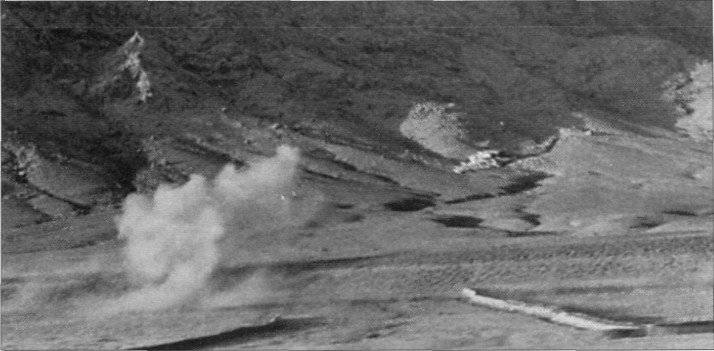
The machine gun was jammed, the gas engine was sticking, the kinematics suffered. The high rate of fire required the same feed rate of the tape, stretching along a winding sleeve, and it often broke during jerks. The use of special two-cartridge cartridges designed for the YakB-12,7 and capable of doubling the density of fire entailed failures due to weak insertion of bullets in the sleeve case: when jerking the tape, they loosened, went out of tilt, and more than once led to bulging and rupture of the trunks. In the 50 regiment, which began combat work in the spring of 1980, thanks to the persistence of the armament service, it turned out that a large part of the failures were factory-made and that those who were on the YakB-12,7 helicopters did not pass the test. There were failures of the control system (tracking synchronization and electric crosstalk), in which the machine gun beat away from the line of sight and did not return to the neutral position. Getting rid of the defect, the machine gun was sometimes fixed along the axis of the helicopter, and the pilot was firing from it with the aid of his ASP-17В automatic sight.
Repeatedly, finalizers came to eliminate defects, the CB tried to solve problems, but the results remained modest. However, partly the malfunctions were caused by harsh operating conditions and not always full supervision of the weapon, which required too much attention in intense combat work, and the service “by state” of the YakB-12,7 was clearly not tolerated. In the summer of 1982 in the 4 Squadron of the Kandahar Regiment of 20 helicopters Mi-24 machine guns normally worked only on seven machines, deserving the ironic interpretation of their name "Allegedly Shoots." The situation almost did not change in the following years, when a significant part of the twenty-four machine-guns replaced the cannon Mi-XNUMHП.
According to the story of A. Maslov, “in May, 1986 was due to a broken machine gun, we had to fly without it at all. Then they worked in the Chakarai area, they hollowed one kishlak, and at my most interesting moment the machine gun was jammed. After the departures until late at night, they were busy with him, everything was smeared, they were tired, but they never did. I had to call gunsmiths from Kabul, they flew in, rummaged and dug with the machine gun, so they did not fix anything, took it off altogether and threw it into the cargo cabin. They flew with a hole in the place of the machine gun, in the cabin through. The next day, a specialist us finally machine gun dolman. When we returned to the base in Kabul, they replaced it with a new one. ”
With the advent of the powerful NAR C-8, new B-8В20 units first of all tried to equip machine guns, compensating long-range missiles for the unsatisfactory performance of the machine gun. By the spring of 1987, in the detachment of the 205 th separate helicopter squadron, assigned to special forces in the same Kandahar, there was only one Mi-24В, in which the YakB-12,7 could not withstand several days without another failure. According to the review of Lieutenant A. Artyukh, who was in charge of armament, “we pulled the whole machine out of us, we couldn’t manage to get it to work steadily, and even had to get a second one to change the one that was stuck. Nothing helped — neither regular cleaning, nor stuffing and greasing of tapes. We already considered flying out without refusal as luck, and it happened that he wedged twice a day. Then suddenly the tape was once again cut off, but the machine gun did not jam and suddenly began to work normally. We were afraid to breathe on it, did not touch or clean, only replenished the tape. What happened - it remained unclear, but he shot perfectly for a month and a half, until the helicopter hit the February 16 ... "
The appearance of the Mi-24P with the double-barreled gun GSH-2-30K performed by 9А623К, which differed by the barrels extended by 900 mm from those used on the Su-25 attack aircraft, allowed to remove most of the problems inherent in machine guns. The fixed installation got rid of the defects of the guidance system, but now the fire could only be conducted strictly along the course, aiming the weapon at the target with the entire machine, and this role was assigned to the commander (which caused the well-known jealousy of the operators remaining on the “bench”). A fair amount of power and recoil even led to tail gagging and loss of speed when firing, and sometimes with a shaking, the AZR and equipment were knocked out.
Depending on the tactical situation and the nature of the target, the pilot could choose the mode of fire at his discretion. Avoiding long queues that "led away" the helicopter, they usually fired, setting the switches to the "Short / pace small" position and, having worked it over, could restrict the fire to single shots. The accuracy of the fire was also excellent: the gun made it possible to conduct aimed shooting to a two-kilometer range, and at usual distances of several hundred meters an experienced pilot cut down a tree or a camel in a caravan with one or two shells. Full ammunition in the 250 cartridges almost never took, being content with 150 shells: with reasonable use, they were quite enough, and a gain of a hundred and a half kilograms of weight in flight had a positive effect on the maneuverability and acceleration characteristics of the helicopter.

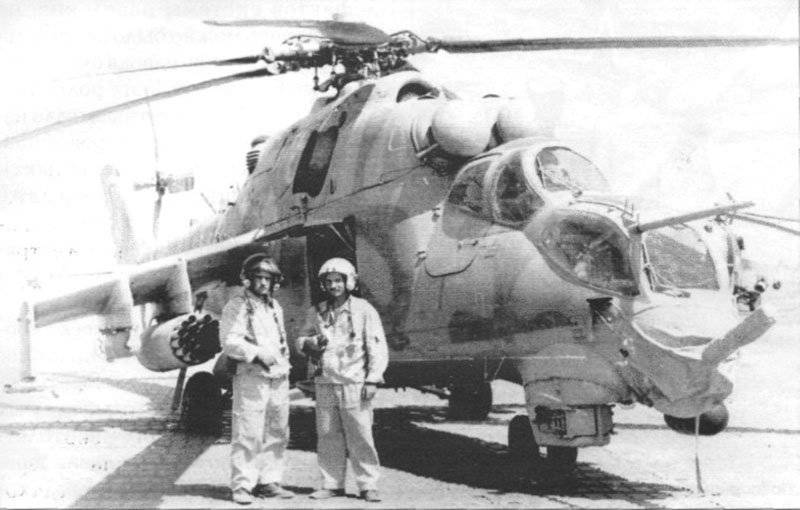
Heavy ribbons were filled with cartridges with 400-gram high-explosive fragmentation projectiles OFZ-30-GSH and OFZT-30GSh tracer, as well as special “multi-element” ME projectiles. The latter contained 28 bullets in bursts with a expelling charge that retained destructive power in 400 m from the point of rupture of the projectile. Unlike machine-gun ammunition, it was more convenient to stack the cartridge belt, filling the cartridge box with the cannon with the cannon (however, in the difficult work of the armament service, convenience was a relative concept). According to V. Payevsky, “usually the tape was placed directly from the boxes in which they were brought to the helicopter without contacting with any devices — it is also faster and simpler. Before charging, it was supposed to lubricate abundantly with gun grease №9, after which two or three of them picked up a weighty and oily, all in grease, tape, trying to fold under its own weight like a fan, then out, then inwards, by the way, each link with a projectile pulls about a kilogram . You hold this weight on your hands, and the "playing" tape clamps your fingers and nails to blue; I didn’t take off the watch, - I think, they are gone, during my service on the Mi-24P I changed about a dozen. ”
Armor-piercing-explosive shells of the BR-30-GSH were used a little: for the “blanks” with a small 14,6-gram explosive charge no targets were found. The fuse designed for a meeting with armor did not work when hitting a weak obstacle, and the projectile could pierce the car through without exploding, and the gaps on the ground, which could be used to correct the fire, were hardly noticeable due to the same low explosive effect, caused by a small amount of explosives.
The gun GSH-2-30K remained a favorite weapon of both pilots and gunsmiths, although with intensive work it could not be without failures. The reasons could be the wear of parts, careless stuffing of ribbons, dirt and sand on the cartridges that blocked the receiver and the gun compartment. According to the regulations, mandatory cleaning was prescribed no later than the next day after application, and after every 600 shots - cleaning the gun with its removal from the machine and complete disassembly (the work is laborious and depleting mass of forces, however, not very effective, because a couple of days later the tape receiver and kinematics were again clogged with dust, which turned the lubricant into a messy mess). Folk remedies and ingenuity came to the rescue: without disassembling, the gun was completely washed with kerosene from dirt and soot and several times distorted the mechanism, removing only gas pistons for more thorough cleaning, which set the automation in motion.
To protect the receiver from dirt, the ribbon was abundantly filled with lubricant, and it went into the gun literally like clockwork, and the dirt and soot together with the spent lubricant flew out. At the same time, the “wedges” were practically excluded: in the 205 OVE in the autumn of 1987, the gun on one of the Mi-24Ps without a single refusal and purges worked for several months, shooting 3000 shells!
The successful location of the gun simplified its maintenance, and the electric ignition of the primer guaranteed against accidental shots not so rare in machine guns. Safety was not the last thing: when jammed, the shell stuck in the chamber was usually cut into pieces, pulling it out piece by piece.
There was a case when the gun helped to save the helicopter on the ground: the one who landed on the forced Mi-24P was surrounded by a gang, and captain V. Goncharov decided to draw more powerful weapons than the automatic weapons of the MSS group. He never had a chance to fight on foot, but he had a gun at hand. The helicopter was manually deployed in the direction of the attackers, the pilot took a seat in the cockpit and made a turn. "Spirits" lay down, hiding behind stones, then began to run across, picking up from the other side. Hanging on the tail, the fighters tossed the helicopter from side to side, and the pilot in short bursts fought off the dushmans until help arrived.
Part of the cannon cars carried a laser rangefinder, coupled with the calculator sight. A rather compact device was made on the basis of marine binoculars adapted for these purposes. The range finder significantly improved the conditions for the solution of the sighting task, giving the range to the target instead of the previous "visual" method of determining the shooting distance, which had a positive effect on the accuracy of the fire.

Mi-24 could carry up to four missile blocks, but this option was considered overload. Each equipped block weighed more than a quarter of a ton (260 kg), and after the launch of the missiles they remained hanging on the suspension in the form of a “sieve”, significantly adding aerodynamic drag, which is usually the case was limited to a pair of blocks. Since for aiming and aiming when firing, the NAR was required to “direct” them by the maneuver of the entire vehicle, the control of the fire from the blocks was brought to the commander. The possibility of firing a NAR by an operator with guidance at the sighting station was also foreseen, since there was a control knob in his cockpit that allowed him to fly in case of a failure of the commander. At the same time, all arms control was switched to the operator’s cabin.
The “division of labor” was also envisaged when using bomber weapons: in this version, the helicopter could carry up to four bombs for 100 or 250 kg or two for 500 kg. On the Mi-24D, the operator carried out the bombing using his KPS-53AB station, the pilot could only drop bombs in emergency mode. On the Mi-24В and cannon machines with a more advanced automatic sight of the pilot ASP-17В, the commander could also carry out targeted bombing. For sighting bombing on the Mi-24D and Mi-24В, the onboard computer for firing and bombing BBC-24 was used, which was usually used in a semi-automatic mode (work in the “machine” in the mountains gave too many misses).
Pilot Mi-24 E.E. Goncharov, who served in the Kunduzsky 181 AFP, said: “Some people said that the sight in the mountains was useless, so the people invent all sorts of ways, draw crosshairs on the windshield, and so on. Even during the preparation, they stated: “in the highlands, TSA-17B and VSB-24 are not applied, as the work in automatic mode is unreliable”. We had to work from a height, keeping higher the reach of small arms, and the scope gave quite normal results. It took, of course, to adapt: at first, the bombs were stacked with an accuracy of up to a hundred meters, or even more, but after a couple of months they began to hit straight into the target, and then it even became possible to reduce the strike groups - three out of four bombs went through direct hits. The crew’s actions during normal operation are greatly simplified. The operator imposes a mark of sight on the target, turns on the mode and accompanies the target, keeping the mark on it. At the pilot's indicator on his sight, the indicator indicates the position of the target, left or right, and he tries to guide the helicopter on the combat course according to the indicator’s directions exactly through the target, keeping the speed and altitude (visually, the target is not visible to him, as it immediately goes under the helicopter). The calculator at the right time gives a buzzer, and the operator can only press the reset button. When you put your hand in, you don’t need to spend bombs on “zeroing in” and even talking on the air is unnecessary with the target designation group and the gunner. ”
However, others relied more on the keen eye and skill, performing bombing on their landmarks, aiming at the tip of the LDPE or the lower edge of the bulletproof glass and reasonably indicating that the result is important and “you have to hit, not aim.”
The usual version of the equipment of the Mi-24 helicopter was a combination of two blocks and two 100 kg caliber bombs. Loading the helicopter with blocks and bombs on the 250 kg was used less frequently. In particular, according to 1984 data, such weapons of the Mi-24 were carried only in 16% of sorties (after all, the helicopter became heavier for half a ton). Bombs were always hung on the outer holders, because the wheels of the main landing gear hindered the inner holders.
"Five hundred" was used infrequently, mainly with extreme necessity. A helicopter with such a load became heavy and unwieldy, and even with the suspension the bombs were very heavy and it was impossible to handle them manually. In addition, after the bombing, the helicopter remained with only one machine gun: they did not take blocks because of overload. In Kandahar for the entire 1982, the FAB-500 bombs on the Mi-24 were used only four times. In one such case, in November 1982, Captain Anatoly Chirkov from the famous “Alexander Squadron” struck at an Islamic committee gathered in one of the villages. The goal was a large mud-brick house-drying room, where local leaders consulted. The object looked like a real fortress, but the "five hundred" with the very first blow covered it and destroyed it along with the "activists".
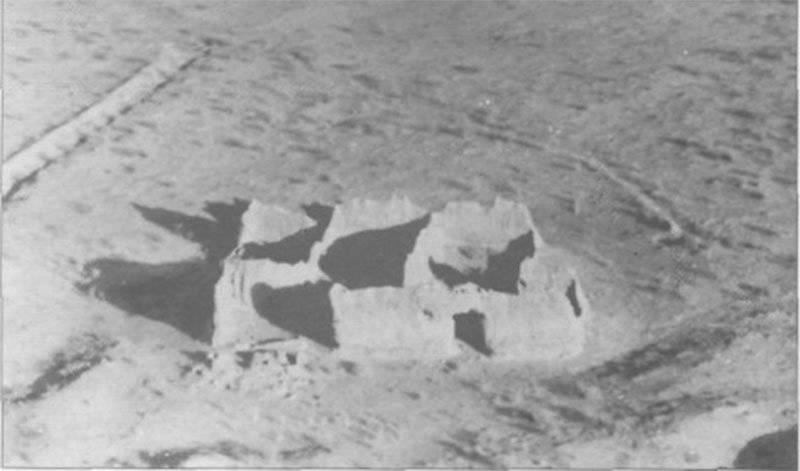
In Ghazni, in May, 1987 was very heavy and did almost no harm to themselves. At night, the group on duty rose to the call of the guard battalion to strike the gang spotted nearby. The target indicated a lighting mine. On the Mi-24 from the evening hung FAB-500, and they worked on the highlighted place. The pilots had just arrived with a replacement and, unknowingly, threw bombs in a volley and from a small height. Helicopters threw a hundred meters, fortunately, not hitting shrapnel. On the ground, they were already met by a komesk: “Five hundred hundred” to set aside, henceforth - only 250 kilograms and one by one ”. It turned out that the tears had formed not far from the residential town, everything was shaking there and the windows were flashing in the modules.
During the modifications to the Mi-24 of all modifications used in the 40 Army Air Force, the possibility of suspending the MBDXNNXX-2 multi-lock bomb racks was provided. Using a pair of such holders, the helicopter could carry up to ten 67 caliber bombs (four on each of the holders and two more on free wing nodes). The accuracy of such a bombing turned out to be low, but a similar version of the weapon, called the "hedgehog", found use in mining. A pair of helicopters provided for the stacking of a sufficient number of powerful bomb "mines" in the right place, putting two dozen "acres" in a hostile village or dushmansky camp and reliably blocking any movement on the approaches to them. For the same purpose, the Mi-100 was being developed for the installation of KMG-U small cargo containers, which could carry both mines and small bombs used for mining. Each KMG-U accommodated 24 mines PFM-1248. When the four KMG-U were suspended, the helicopter could sow inconspicuous mines “butterflies” over a wide area, in the strip of which the area and density of mining depended on the unloading mode set by the container's management, which had four different emission intervals for blocks with ammunition - from 1 to 0,05.
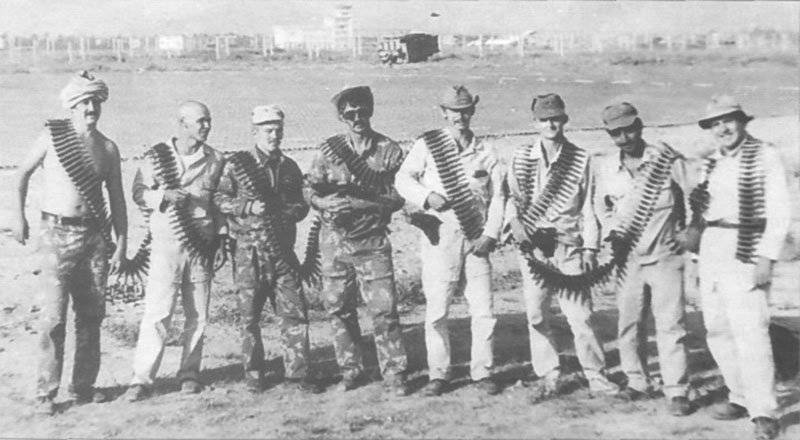
Helicopters also used space-detonating aerial bombs (ODAB) - a new weapon and at that time not familiar to anyone. Taking advantage of the opportunity to test them in a combat situation, the ODAB was put into action in the first military year. In practice, however, it turned out that the ammunition of an unusual device with the contents of a liquid explosive that requires a whole system of charges to disperse and detonate a detonating cloud is quite capricious and sensitive to external conditions. The formation of explosive mist could be affected by the temperature, density and humidity of the surrounding air, as well as the wind, which prevents the creation of an optimal concentration of aerosol enveloping the target. As a result, not all dropped bombs worked (according to the experience of the Americans, who for the first time tested the ammunition of a volume explosion in Vietnam, they exploded from 30 to 50% of such bombs).
It seems that for the first time the use of ODAB from helicopters took place in August of 1980 by the pilots of the Kunduz squadron Mi-24. Eliminating the Dushmansk ambushes in the Faizabad gorge, the helicopter pilots worked as a link in which the lead pair carried two ODAB-500, and the closing - blocks with rockets. Zamkomeska Alatortsev described the organization of the raid in the following way: “They walked at a height more than usual, keeping at 300 meters, since ODAB had no fragments, but the new building has a lot of excitement and when triggered, these pieces of iron fly up meters to 200. The bombs themselves are also some unusual, ingots with a rounded snout, like barrels, with a squish inside. We were led to the conclusion that not everything went well during the ODAB tests, something in the stuffing did not work as it should and could not detonate. We decided that the process will support rockets, so it happened. After dumping, a cloud rose below, even seemingly heavy and viscous, and missiles from the followers immediately entered this oily fog. Burst be healthy, threw helicopters, only his teeth clanged. An explosion in appearance also does not look like ordinary bombs, from which only a dusty fountain and a smoky cloud, and here - a flash and a fireball, swirling long below. The shock wave of a bomb is harder than that of ordinary ones, and of course, everything finishes down there with fire. The effect is a combination of shock pressure, like a high-explosive, and high temperature. The paratroopers told later that the “spirits” that remained in place were in a terrible form - the corpses were burned, their eyes were broken, and those who survived were shell-shocked, with torn lungs, blind and deaf ”.
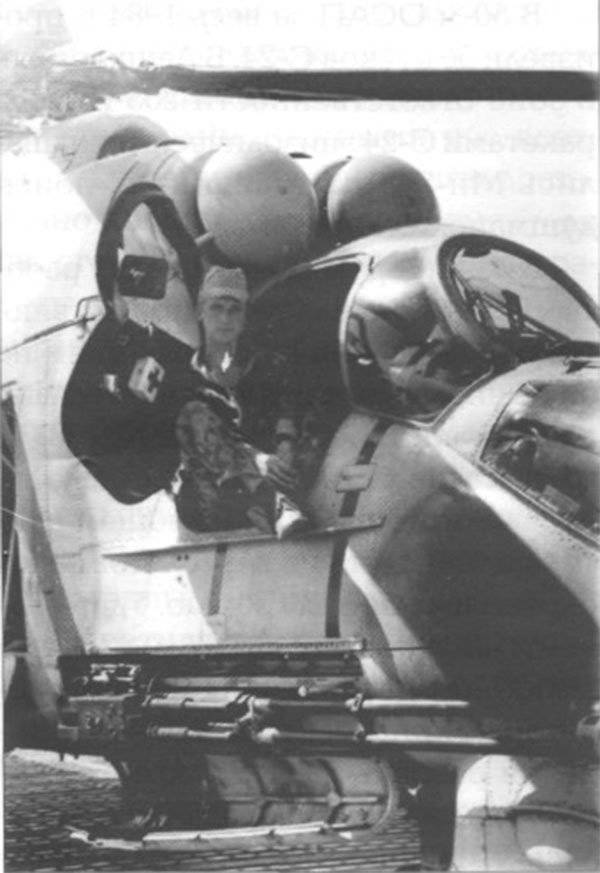
With successful use ODAB in the Afghan situation turned out to be even more effective weapon than other ammunition. The hot cloud of volumetric explosion penetrated into the caves and mountain crevices, with a fiery blow covered the stone placers and labyrinths of duvali, overtaking the enemy where he was invulnerable to ordinary means. The ODAB was also used in the landing of airborne assault forces, when, before landing, helicopters needed to quickly and over a large area eliminate the threat of mines. The dropped ODABs passed through the front of the shock wave with high pressure, instantly freeing it from mines.
Store ODAB with sensitive content was supposed to protect from direct sunlight and overheating. In fact, there were no sheds in the ammunition depots, and it’s good if the bombs covered at least a tarpaulin from the sun (“it’s the Americans that the soldiers, the bombs, the air-conditioned warehouses for them”).
However, the use of ODAB was hindered not only by the features of the device: it turned out that these weapons, in addition to efficiency, had earned the reputation of “inhumane” as a number of conflicts, as causing excessive human suffering. The UN managed to condemn a voluminous explosion ammunition as contrary to accepted standards of warfare. The Geneva Emergency Committee on Conventional Weapons in 1976 and at all was adopted a resolution on the recognition of the volume explosion of ammunition as a weapon, on the basis of qualifications requiring a ban. Although none of the countries possessing such weapons thought to part with them, the opinion of the international community had to be taken into account. In case of the arrival of journalists and all kinds of foreign representatives, who occasionally appeared in Afghanistan with humanitarian missions, they tried to remove the bombs away from someone else's eyes and fight only in a “humane way”.
The destruction of manpower remained the primary task of the anti-guerrilla war: NAR C-5C and C-8C were involved, stuffed with blocks of steel feathered arrows at 1100 and 2200 pieces, respectively. Shooting them, however, demanded careful keeping of the range, so that the bundle of "grapeshot" retains its lethal force and does not fly apart in vain. The use of munitions that "indiscriminately" resolved everything in their path with a shower of arrows, also contradicted a number of international conventions, because of which the 40 Army's air force command, guided by "descending from above" orders, then forbade them, then again allowed them, although the pilots highly appreciated This weapon of "local mass destruction". Helicopter pilots in Faizabad in the winter of 1981 were once brought about fifty boxes of C-5C. Shot them in a day, asking for more. Instead of ammunition, the head of the regiment’s weapons service rushed in, demanding to immediately return all the rockets with “nails” back. Of the six hundred pieces, only two, “crooked” ones, were able to show him, which lay only because they did not climb into the trunks.
Rocket blocks for 57-mm C-5 projectiles with 1982 have begun to replace the new B-8В20 launchers for more powerful C-8 type NAR caliber 80 mm. Under them, the cars that were in service were being refined, and the helicopters of the new series immediately received more modern weapons. The superiority of the new missiles was so convincing that to speed up the re-equipment of aircraft, a special government directive document appeared - a resolution of the commission on military-industrial issues under the USSR Council of Ministers from 27 in July 1984 on the accelerated implementation of NAR from the C-8 family. With reference to the Afghan experience, it was necessary to increase the production of new missiles, increasing production volumes by reducing the production of 57-mm projectiles.
However, C-5 did not stop using until the last days of the war.
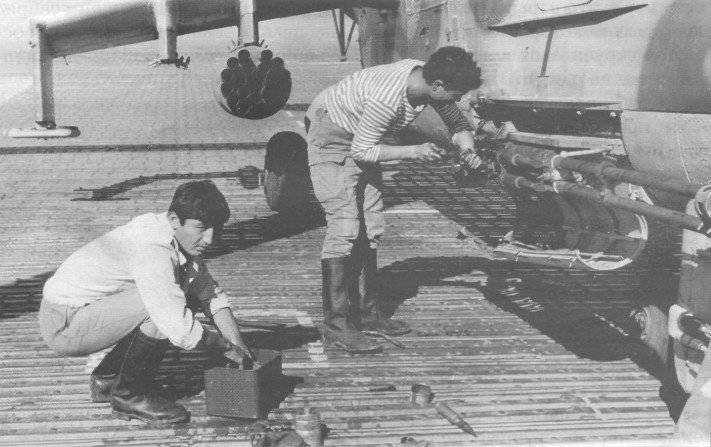
Projectiles of various types and models were used, and from time to time NAR of the earliest samples were brought in among the imported ammunition. To expend accumulated supplies, the rear personnel cleaned up warehouses in the Union, and even C-5 of the first modifications that looked like real rarities were imported in parts. Such products were not only low-power, twice as inferior in the striking action as more modern models of the family, but also required much more time and effort in preparation: each such rocket was required to be equipped with a fuse, which was driven separately, which was screwed into the hull before charging. Considering that only one helicopter had to prepare 64 rockets, one can imagine how much trouble it cost. There were even C-5M and C-5K shells of the 1950-x model, which had their own electric plugs, each of which had to be inserted into the corresponding connector of the unit during charging, and the unit itself was refitted with the installation of a set of additional parts. Many of these "antiques" twenty years ago and did not have time to find a home, and how to handle them - only veterans of weapon groups remembered. The newer shells had a built-in fuze and required much less care, being immediately ready for use.
Some of the Mi-24 were modified for the installation of large-caliber missiles C-24 and C-25, as well as C-13, used in five-charge blocks. The advantage of large-caliber missiles was an impressive range of targeted launch, which allowed them to hit targets from a safe distance without entering the enemy’s air defense zone, but the widespread use of such weapons was hampered by the characteristics of the missiles themselves equipped with a powerful engine, which could have caused a surge in the helicopter’s power plant. The car when launching heavy NAR literally overwhelmed the plume of the gases of the rocket “powder pump”, and for firing it was necessary to carefully maintain the parameters of the flight of the helicopter, while launching the missiles turning its engines to reduced mode.
In 50, the OSAP for heavy C-24 missiles in 1984 converted four Mi-24s, a part of the 335-OBB, 280-th and 181-AFP helicopters underwent a similar refinement. There were also such machines in the 262, 205, and 239, individual squadrons. The launches were entrusted only to the most experienced pilots, and then heavy shells were used only from time to time, when it was necessary to defeat the targets protected and covered by the anti-aircraft barrier. In addition to high accuracy, the projectiles provided a significant lesion area, especially when equipped with a non-contact radio fuse PB-24, which undermined the projectile above the target, showered with thousands of fragments from above, from the most unprotected side.
In 50, the OSAP for the entire 1984 produced 50 C-24 starts. In Lashkargah, in the area of responsibility of the 205 OVE, C-24 missiles were occasionally equipped with Mi-24, which took off to search for Dushman caravans.
In the Kandahar 280 regiment, work with the C-24 led to an incident directly with shells and not connected, but ended with a helicopter crash. In August, 1987, a group of Mi-24s, flew out in the morning to strike, but when approaching a shaving against the sun, one of the helicopters hit a dune and “plowed” the ground. The blow was so sensitive that the pilot's door and the operator's hatch jammed. I had to shoot from the machine guns to break the lights in order to get out. In justification, it was said that the car was heavily over-heavy with a suspension pulling per ton. Nevertheless, the pilots were subjected to "the highest measure", having been written off from flight work to aircraft navigators. Victims could consider that they were still lucky: the helicopter was pretty deformed from the impact, being literally a twisted corkscrew. The repair team struggled for a long time to restore it, but no one dared to fly the “invalid”, and it was written off to one of the schools as a visual aid.
The use of even more impressive C-25 was limited to a few test runs. Not all airplanes could carry a four hundred kilogram projectile, and the C-25 descent by helicopter was accompanied by such a plume of flames and a roar that they all decided that it was not a helicopter weapon.
The equipment of the Mi-24 guided-weapons complex set it apart from other types of aircraft and helicopters that were part of the 40 Army's air force. Attack helicopters were the only ones who had such a weapon for quite a long time - until the very 1986, when they began to use guided missiles on Su-25 attack aircraft. However, in subsequent years, the guided weapons did not become mass weapons on attack aircraft, and were used only sporadically, being quite expensive weapons. It was trusted only to the best trained pilots.
In contrast, virtually all crews of the Mi-24 could operate guided missiles, and helicopters carried anti-tank guided missiles literally on every flight. In a decisive way, this was facilitated by the sophistication of the guided weapons complex, its good development by combatant crews, as well as the low cost compared to other types of guided weapons. ATGM had a high efficiency, good accuracy and great destructive power with a significant firing range, which was limited practically only by the possibility of visual visibility of the target.
At first, however, cases of using anti-tank guided missiles were infrequent. So, for the entire 1980, the number of ATGM used was limited to 33 units. During this period, the Mi-24D helicopters were predominantly in Afghanistan. This modification carried the Phalanga-PV missile system 9P145 with a semi-automatic radio command guidance system, which was quite effective and provided a firing range to 4000 m. The missiles were quite impressive products that had a wing with a small meter span, because of which their presence on the suspension was reflected on helicopter behavior. The bulkiness of the “Phalanx” also affected the preparation of the machine. The ATGM was delivered in a heavy sixty-kilogram box that needed to be dragged to the helicopter, with all precautions to remove the rocket, deploy and fix the wing, check the air charging, condition of the tracer and pipelines, letter and guidance system code, then install the weighty product on the guides, connect the connector, fix it and remove the clamp from the steering wheels. The whole procedure took 12-15 min.
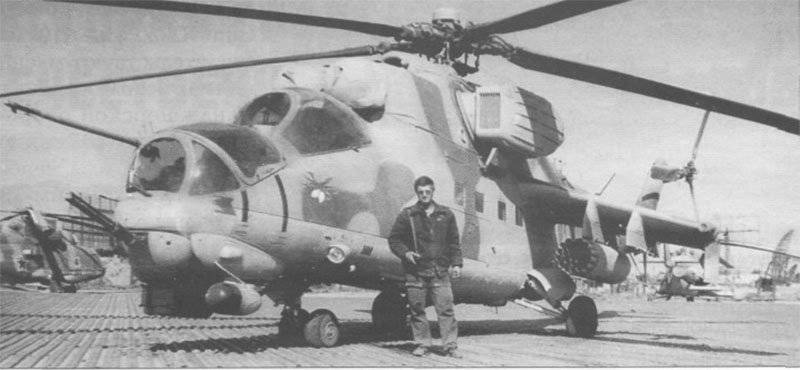
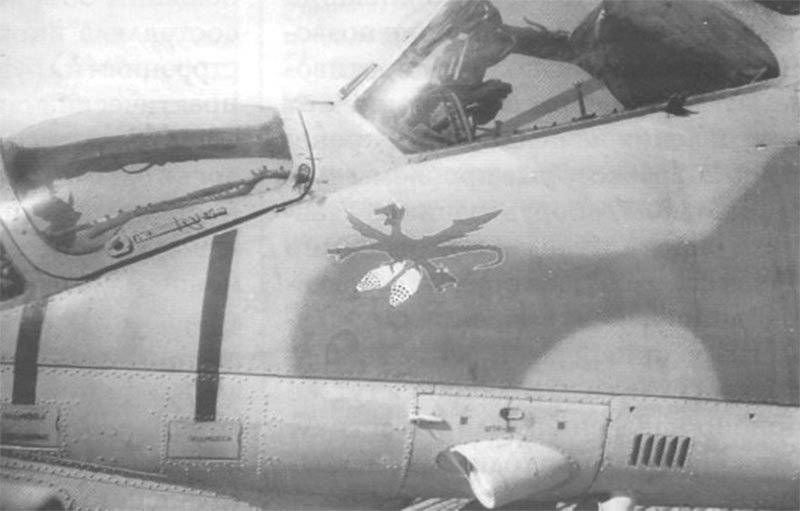
Soon, the units began to receive more modern Mi-24В, distinguished by new pilot sighting equipment, instead of the old simple collimator sight, as well as the new generation 9K113 “Sturm-V” missile complex with 9МXNNXX supersonic missiles. The advantage of "Sturm" was not only increased accuracy and range, brought to 114 m, but also a successful solution of the rocket, delivered directly in the launch container tube, in which it was suspended on a helicopter. Plastic pipes were convenient in transportation and storage and extremely undemanding in preparation: to install the Sturm, it was enough to place the container on the supports and turn the locks by turning the handle.
The rockets themselves were delivered in the Sturm-V and Sturm-F versions with a five-kilogram cumulative and high-explosive warhead. The latter had the equipment of a volume-detonating effect with liquid explosives, in the device of which it was possible to get rid of the shortcomings of the first samples of such ammunition, and was distinguished by much greater reliability and efficiency. It is curious that in the ranks, many did not even guess about the rocket stuffing, considering that it carries the usual high-explosive charge (“Sturm-F” differed from the anti-tank cumulative version by a noticeable yellow stripe on the launch tube).
The launch of the ATGM was carried out by the operator who directed the missile with the aid of the Raduga-Sh sighting system (on the Mi-24D, the equipment of the former “Phalanx” configuration of the Radut-F was used). Having found the target with the help of the optics of the guidance device, the operator transferred him to a narrow field of view and then kept the mark on the target, and the radio command line itself led the missile before it hit. Installing an optical observation head on a gyro-stabilized platform helped to keep the target in sight and hold the label imposed on it, and the supersonic speed of the rocket shortened its flight time before meeting with the goal and, accordingly, the operator was busy hovering to a few seconds (before on a combat course, twice or three times longer, which was unsafe with the anti-aircraft influence of the enemy). Stabilization of the field of view during guidance allowed the helicopter to perform anti-aircraft maneuvers with evasion from direction to target to 60 ° and rolls to 20 °. The work of the machine gun and especially the cannon delivered some problems to sensitive equipment: the thundering weapon shook the car; due to vibrations, hydraulic dampers flowed, and the working fluid flowed into the pointing device located right there, flooding the optics. The “Rainbow” block had to be turned up and cleaned of oily liquid (someone who did a better job turned off the plugs, drained the liquid and somehow wiped the glass with a cotton swab on the wire).
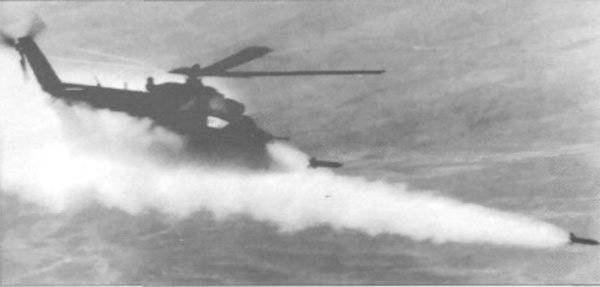
All these advantages of the ATGM were highly appreciated by the pilots, and the Sturm became a very popular weapon. The striking action of the rocket was enough to fight a wide variety of targets, from cars in dushman caravans to firing points and shelters. It did not play a special role, the high-explosive rocket or cumulative was used - the power of the charge, capable of penetrating the half-meter armor, was more than enough to smash a blown or other structure. It was commonplace to fire anti-tank guided missiles at maximum distances, on the order of 3500 — 5000 m, including anti-aircraft weapons for clearing the action area of the strike force. High-explosive "Sturm" became particularly effective with the defeat of the caves, in which the entrenched enemy for other means was almost invulnerable, and his fire from there turned out to be destructively precise. The limited volumes ideally contributed to the operation of the rocket filling with the most effective development of a high-explosive strike.
The massive use of ATGM as early as 1982 was evidenced by the scale of their use in the Panjshir operation: from 17 May to 10 of June this year, in less than a month, 559 guided missiles were spent (on average, a dozen for each participating in combat Mi-24 actions).
The accuracy of the ATGM hit on small objects such as a truck was of the order of 0,75 — 0,8, and for buildings and other similar targets it was close to unity. A curious remark was contained in one of the reports on the effectiveness of equipment and weapons: the interviewed pilots complained that the use of ATGM was constrained by “an insufficient number of suitable targets.” As an example, the actions of the helicopter crew of the squadron commander of 181-AFP Lieutenant Colonel N.I. Kovalev, who destroyed a month of combat work on the Mi-24P with eight “Sturm-B” missiles, eight objects of the rebels, i.e. each missile was laid right on target (Hero of the Soviet Union Nikolai Kovalev died with the entire crew of 1 on June 1985 in a downed helicopter that exploded in the air after the DShK crashed).
There were many examples of successful use of the Sturm, including in dueling situations against firing points and anti-aircraft weapons. In August, the 1986 helicopter link of the 181 regiment of helicopters under the command of Major A. Volkov flew out to strike the shelter of the local leader, “engineer Salim”. The village in the mountains near Pul-i-Khumri, which served as the base of the dushmans, had a good anti-aircraft cover. With this in mind, the attack was planned with the use of an ATGM, and the departure itself was scheduled for early morning. The first call of Mi-24, Senior Lieutenant Y. Smirnov, “Sturm” was thrown right into the structure, burying its inhabitants in dusty ruins.
Several times ATGMs were used "for their intended purpose", to combat armored vehicles - in the hands of the armored personnel carriers of armored personnel carriers and tanks. On January 16, 1987, the helicopter pilots of the 262nd OVE received the task of destroying an armored personnel carrier captured by the souls, from which they fired at security posts at the Bagram airfield. The Mi-24 link was lifted into the air, in three rounds of anti-tank guided missiles fired at for the purpose, and to guarantee that they also worked with cannon fire and salvos from NAR, after which they were pleased to report “peace and quiet” from neighboring posts. A couple of months later, the Mi-24 link flew out to suppress the annoying firing point near Bagram. All helicopters launched four “Assaults”; returning pilots reported the observed hits exactly through the windows of the blow.
Confirmation of the effectiveness of the "Sturm" on the Mi-24В, as well as the aiming complex with good capabilities standing on it, was the prevalence of the "striped" of this modification, soon the "survivors" of the previous Mi-24Д. Thus, by the autumn of 1984, in the Kunduz 181 AFP, there was only one Mi-24D, which they tried not to send to combat missions, using it as a cohesive and “mailer”.
The original revision was carried out in the autumn of 1987 in Kandahar, where a dozen cars each received two APU-60-1 launchers for borrowing from the P-60 missile fighters. These missiles, designed for melee air combat, were to be carried by helicopters in case of encounters with “spiritual” airplanes and helicopters, reports of flights from the Pakistani side appeared from time to time, but it was not possible to meet them live. The P-60 on the left pylon was intended for air purposes, the right AAP was tilted down so that its thermal seeker could capture a ground “hot” target — a fire or a motor vehicle engine. According to the results of the P-60 tests on helicopters, however, it was known that rockets for similar air targets with low thermal contrast were not very effective and were able to capture someone else’s helicopter with a maximum of 500-600 m, and even less piston “intruder”.
The P-60 was also installed on the Mi-8, but the author is not aware of the success of their use.
In addition to improving the effectiveness of weapons, attention was paid to their reliability. It was possible to increase the resource of many systems and their “performance” as a response to the tense operating conditions. The list of innovations and improvements was endless - from new types of ammunition to more “hardy” steel grades and REO elemental base that can withstand the toughest modes of operation.
One of the problems that could not be solved was the provision of night work. The need for departures to search for the enemy, who was freer to feel under the cover of darkness, remained urgent all the time, but the share of departures, and most importantly - their effectiveness, was small. To highlight the strike site, helicopters carried 100-kg luminous bombs (SAB), which gave a torch with aperture 4-5 million candles for 7-8 minutes (time sufficient for a couple of attacks). If necessary, it was possible to illuminate the target immediately, launching special NAR C-5-O along the course, hanging powerful torches on parachutes in 2500-3000 m in front of the helicopter. However, the attack required first to detect the target, and the helicopter pilots did not receive sufficiently effective night-vision devices and night sights. When patrolling, night driving goggles of the NVD-57E technique were used, however, they could only see a general “picture” of the area at a short distance. Tried to work with tank sights, the note had a limited range, distinguishing the machine at a distance of 1300-1500 m. Night reconnaissance surveillance devices had a low resolution.
We had to rely on moonlit nights, a keen eye and good fortune, which allowed us to notice a crouching caravan or a campfire campfire. Such sorties were entrusted to the most experienced crews, and yet their effectiveness remained low, and the ammunition consumption was irrational. At the site of the strike in the morning, no traces of the attacked enemy were usually found (if anything remained after the raid, then the weapons and other things had time to be taken away by the survivors). At the same time, the risk of hitting the cliff in the dark or hitting another obstacle during the maneuver was too great, which prevented night work every now and then, making an exception only for round-the-clock patrolling of the familiar surroundings of garrisons and airfields, which protected them from shelling and sabotage .
Another permanent and, in the literal sense, vital factor was the improvement of the security of the Mi-24. Reservations for the Mi-24 were recognized as good: in addition to the overhead armored steel screens on the sides of the pilot’s and operator’s cabins (contrary to popular belief, the helicopter’s armor was laid on and attached to the structure on the outside with screws), the crew covered the front bulletproof glass of impressive thickness, and the pilot’s seat was fitted with an armored armor and armored headpiece. Armor on the hoods were also protected by engine units, gearbox and hydraulic unit.
Nevertheless, with the increase in the number of fire weapons from the enemy, helicopters were increasingly subjected to fire, the caliber and power of anti-aircraft weapons increased, the number of hits multiplied, becoming a real and very tough test for vulnerability and identifying weak points of a combat helicopter. As for the protection of the crew, most of the bullets were in front of the operator’s cab, whose armor could not always withstand large-caliber weapons. From the number of bullets “taken” by the operator’s body armor, 38-40% pierced it, while the pilot’s share was half that, 20-22%. Even without penetrating through armor, a heavy bullet from a DShK or ZSU was able to knock out a lot of secondary fragments from the back of the armor sheet, which were quite dangerous: small steel chips slipped into the cabin, causing injuries to pilots and equipment, electrical accessories and other cabin stuffing. In no case were powerful frontal bulletproof glass punctured by bullets and shrapnel, even when hit by 12,7 caliber bullets. At the same time, the return of helicopters with multiple traces of bullets on bulletproof glass was noted (in one such case, marks from six bullets remained on the glass, which turned it into a token, but never passed inside).
In most cases, the crew suffered from the defeat. However, no matter how cruel it may sound, the commander’s best protection was calculated and decisive, having his own rationale for the survival of both the machine itself and the crew: the pilot who was able to work could reach home even on a damaged helicopter and when other crew members failed, while his death or even injury of such an outcome was not promised (up to 40% of helicopter losses occurred precisely because of the defeat of the pilot).
During the Panjsher operation, on her very first day, 17 in May of 1982, two Mi-24 were shot down at once. The cause of the defeat in both cases was the aimed fire from the ASC in the cockpit, which led to loss of control, a collision with the ground and the destruction of helicopters. Another car came under fire from an anti-aircraft gun, at an altitude of 400 m, but the bullets went into the cockpit, breaking the windows and wounding the pilot. Rescued the crew's squalor: the flight engineer made his way to the commander and helped him, and the operator intercepted the control, and he brought the crippled helicopter home.
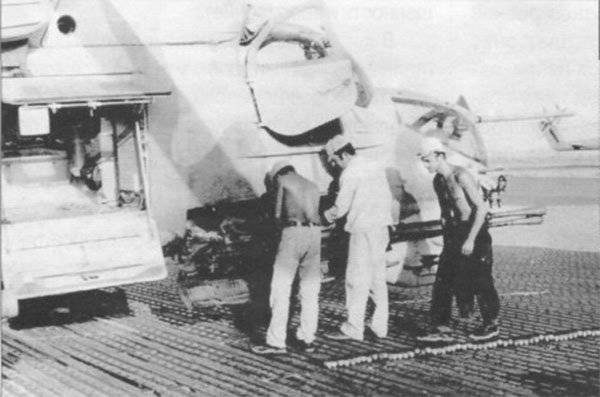
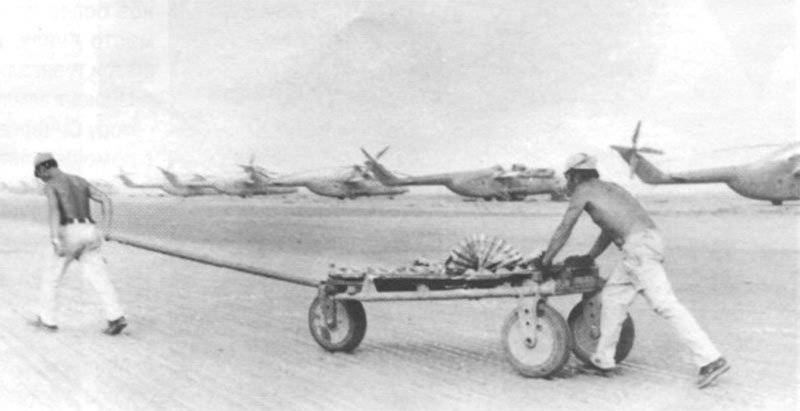
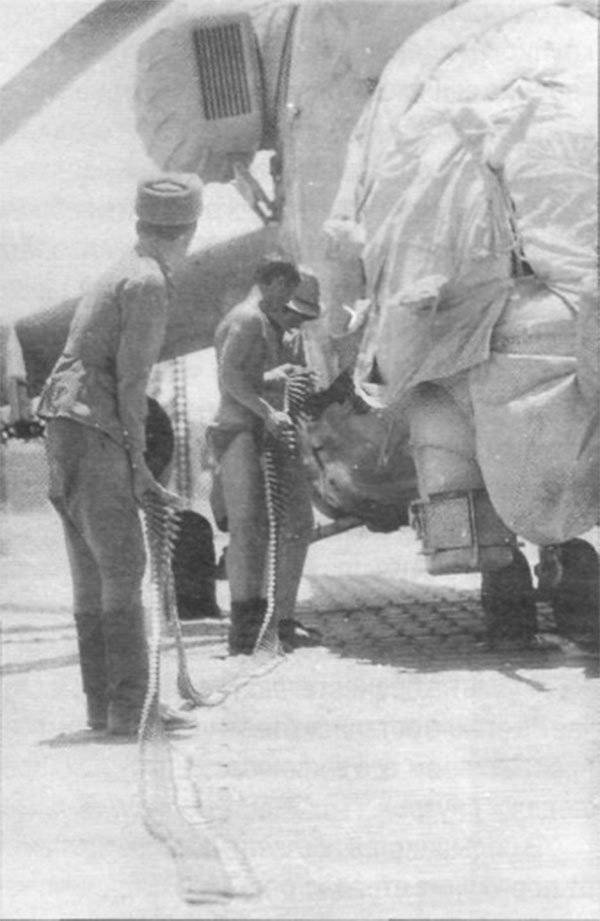
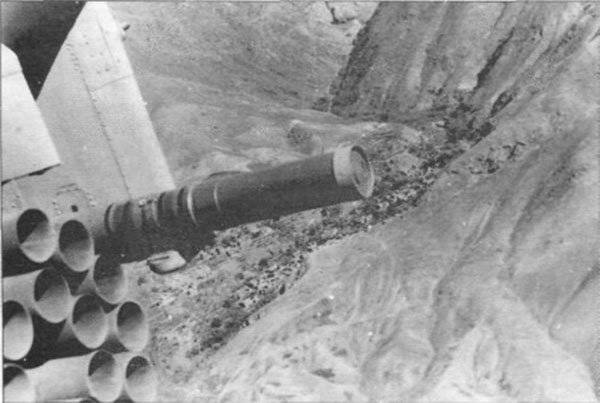
When returning from the 1 October 1983 night reconnaissance flight, Mi-24 of the Jalalabad 335 OBVP came under concentrated fire from grenade launchers and machine guns. The hits hurt the propeller blades, cut through the control rods and the engines. The blow also fell on the cockpit. Operator Lt. A. Patrakov, who died of wounds in a hospital a week later, was seriously injured at his workplace.
22 on April 1984, during an operation to seize the Dushman warehouses near the village of Aibak, in the area of responsibility of the 181 ORP, who were covering the troops Mi-24, were under fire disguised by the DShK. Shooting was conducted from the caves on the mountainside, point-blank. The first turn took place on the leading helicopter. Having pierced the side, two large-caliber bullets wounded operator V. Makarov in the arm (as it turned out later, 12 was smashed in the elbow joint). The lieutenant, who was barely 23 of the year, lost consciousness, but then regained consciousness and, as he could, continued to help the commander in flight (after spending nearly a year in hospitals, he returned to service and flew again).
Covering 16 August 1985, the evacuation of the wounded in the village of Aliheil under Gardez, a pair of Mi-24P Kabul 50 th OSAP engaged in the suppression of enemy firing points. As it turned out, spooks well equipped positions and had not only small arms, but also large-caliber installations. The flight commander captain V. Domnitsky described the incident as follows: “At the exit from the attack, the helicopter was hit again, and again this nasty, pungent smell of burning metal in the cabin ... I need to cover the slave, but I feel that my hand is numb from the efforts step-gas, the lever stretches with difficulty. He raised his hand, and on it from the back of a half dozen holes and blood is oozing from them. He immediately found two fragments in the leg above the knee, and on the left side of the board he turned the fuel system control panel. On the ground, after turning off the engines, they found out that the DShK bullet pierced the helicopter from the bottom, then the folded armored headpiece (smooth, clean hole), then knocked out a decent hole in the armored seat of the chair (the blower was still pushing at the impact), ricocheted to the left side , mixed the switches and the fuel system wiring, ricocheted again from the invoice of external armor on board, hit the cabin ceiling and more ... Found it in a parachute chair. 17 splinters were pulled out of my hand then. ”
Despite the injuries (fortunately, minor), the same day, Captain Domnitsky again flew into the air in his helicopter. However, fate had already made its choice: having prepared for the meeting, the enemy was waiting for them in the same place where Mi-24 again fell under aimed fire. The helicopter shook the battles of the DShK, one of the engines turned out to be shot through, and then all that remained was to pull on the forced landing. Flopping on a track winding down the slope, the only more or less flat place below, the helicopter demolished the chassis and fell to the side, buried in the ground. The pilot-operator S. Chernetsov had to break the glazing with a machine gun in order to pull out the commander and the flight engineer.
A month later, on September 14 1985, in the same helicopter squadron of the 50 OSAP, the operator Mi-24, Lieutenant A. Mironov, was killed. During the operation in the area of Kunduz, the task was carried out in the north, near the border, faced with the enemy’s dense fire. The hit had to be on board near the front cockpit, and the strike was unusually strong. Commander S. Filipchenko was able to land the helicopter, but no one could understand what hit the car, which had many holes in its side, there were a lot of dents on the armor of the cabins several centimeters like from heavy shot and like burned holes, and the body of the deceased operator it was literally riddled. Apparently, the Mi-24 fell under the RPG shot, a cumulative grenade which was able to penetrate even a tank. When firing at helicopters, dushmans used RPG fragmentation equipment from a long distance, with a calculation of grenade triggering on self-destruction that took place at a distance of 700-800 m. At the same time, an air blast was carried out without a direct hit, which gave a directional and powerful fragmentation strike that could cause multiple damage.
A reminder of the formidable "storm" in the 335 OBVP was stored with armored spacecraft A, Mikhailov, who was killed by 18 in January 1986 was already on the boarding course with a sniper bullet piercing the side of the helicopter and helmet. In another case, in Ghazni, the ZS-56 titanium armor saved the pilot, retaining an impressive dent from the slipping line (but not protecting him from the ridicule of colleagues - “not every head will stand against the DShK!”).
As an emergency measure, in the first military year, on the Mi-24, they began to install additional armored glass cabs. Since the pilots were open to their forearms at their workplaces, in the cabins along the sides, from the inner surface of the blisters, special glass blocks of bulletproof glass were fastened in frames with brackets. However, this refinement was not very successful: almost in 2 times the useful volume of the cockpit in the blister area decreased, the view deteriorated due to the massive frames, which the pilots literally touched with their heads. In addition, the armored glass was very massive, giving weight gain in 35 kg and affecting the centering. Because of its impracticality, this option was soon abandoned (by the way, as part of the booking in the G8 cabins was also abandoned in favor of maintaining a review that is no less important in a combat situation than security and armament).
During the modifications, the five-millimeter steel sheets were additionally shielded with oil and hydraulic pipelines, the tanks were filled with polyurethane foam sponge, protected from fire and explosion. The cable management of the tail rotor was smashed on opposite sides of the tail boom in order to reduce its vulnerability (before both cables stretched side by side and they were repeatedly interrupted by a bullet or a splinter). In addition to the obligatory EVD, Lipy and ASO traps (without which, as they said, “Baba Yaga” would not have flown in Afghanistan), there was also a place for active defense means.
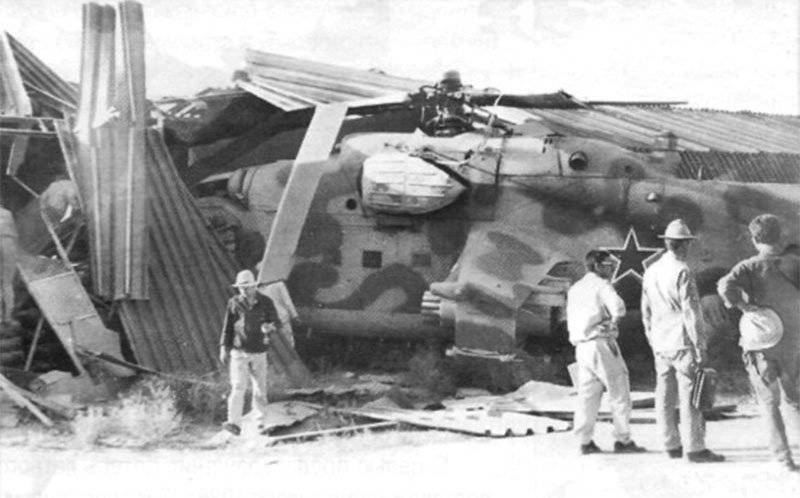
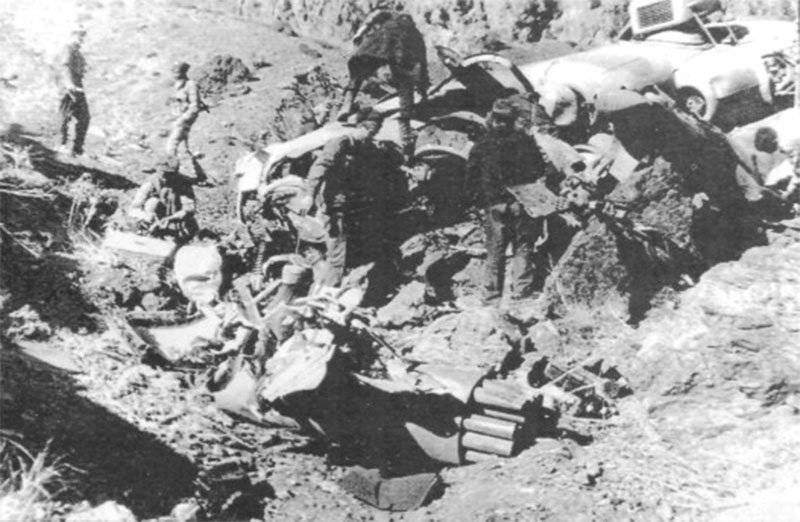
A noticeable drawback of the Mi-24 was the absence of a stern firing point. At home it did not take anyone, but in a combat situation began to cause complaints, especially in comparison with the Mi-8, whose "tail" was covered. The statistics confirmed the impressions of the pilots: avoiding being hit in front of the enemy. The enemy tried to hit the helicopter from unprotected rear angles. Thus, the Mi-24 cockpit glazing accounted for only 18-20% damage from bullets from the front hemisphere, versus 40-42% in Mi-8 (this was partly explained by the smaller twenty-four glazing area). With regard to damage to the power plant, this dependence was even brighter: dust coca intakes that encountered the front bullets received less hits on the 24 of the Mi-1,5 than on the Mi-8 (16-18% against 25-27%).
The provision of the “eights” with fire protection of the rear hemisphere (which the enemy was soon convinced from his own experience) in many cases made the dushmans refrain from firing from the previously attractive feed angles. The presence of a tail gun also had obvious advantages in tactical terms: the number of hits on a departure from the target of the Mi-8 was half that of the Mi-24, which could be fired without fear of “surrender” (in the figures: Mi-8 at the exit from the attack received 25-27% hits, while Mi-24 at a distance from the target received 46-48% hits from their total).
Helicopter protection from fire from vulnerable areas on the Mi-24 was done by a flight engineer who was in the cargo hold. It was extremely inconvenient to shoot out the vents, as it was foreseen by the creators of the helicopter, due to the limited view and sector of the shelling. To expand the opening when firing, the opening flaps of the landing compartment were used, which made it possible to direct the fire sideways. In the landing cabin they kept a machine gun (usually the same reliable PKT), with fire from which the flight engineer protected the helicopter at the exit from the attack, when the target went under the wing, disappearing from the field of view of the pilots, or turned out to be at the side during a combat reversal.
For quite a long time machine guns had to be taken from broken Mi-8 or bargained from neighbors, and only with time did they enter the state (usually one for each helicopter of the squadron, plus one spare). Many crews were not limited to one barrel and took two machine guns each, defending both sides and not wasting time carrying fire. On board, an impressive arsenal was accumulating, just in case, they also grabbed a light machine-gun (it was impossible to fire from a PCT). In addition, each of the pilots, in addition to a personal pistol, always had an obligatory machine gun - NZ in case of an emergency landing or a parachute jump (so as not to lose, he was often fastened with a belt to his hip). The navigator-operator A. Barley from the Bagram 262 OVE shared the weary feelings: once, climbing into the cockpit, he hung up the machine gun on the LDPE and, forgetting about it, took off. He realized that he was already in the air, not feeling the usual weight on the side, but after looking around, he remarked: “The AKS was left behind, dangling in front of his nose, but you won’t get it ... felt like naked ...”
Household crews seized captured machine guns in reserve, and the re-equipment of the Mi-24 depended only on the crew’s ability to obtain and install additional weapons. All sorts of “self-made” modifications were common — stops and sights, right up to sniper rifles. The disadvantage was the inconvenience of shooting from a low cabin, where you had to stoop or kneel. He very elegantly solved this problem in the 280 regiment, Captain N. Gurtova, having gotten his seat from the G8, which he adapted to the central rack of the landing compartment and, without rising, turned on it from side to side when carrying fire.
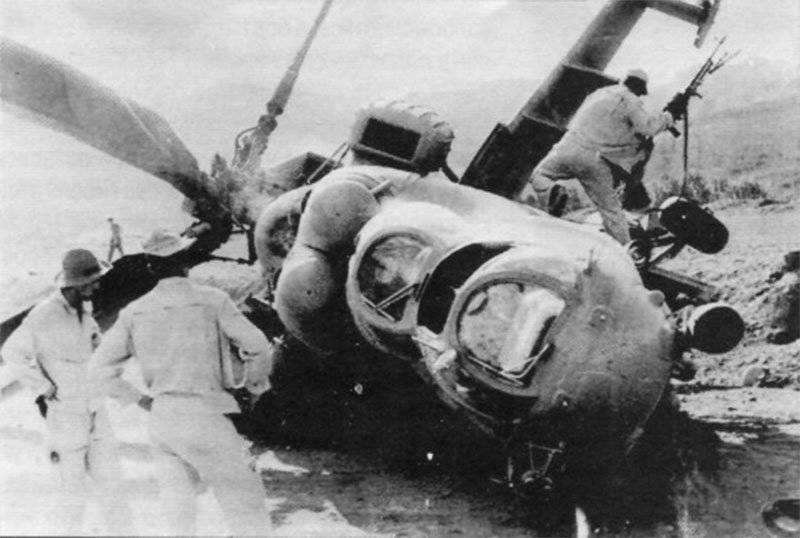
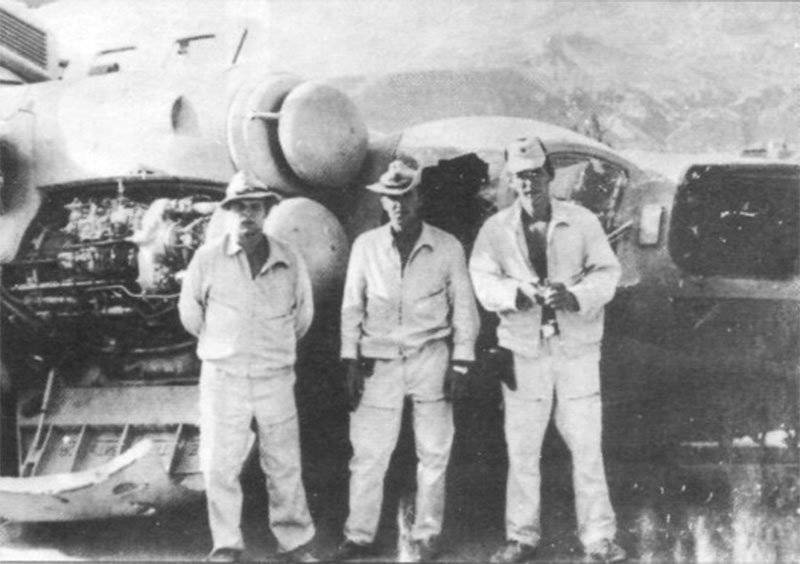
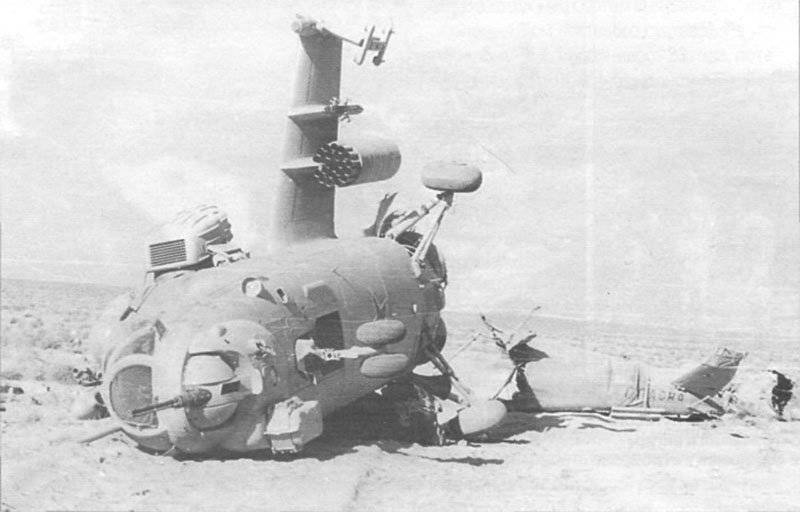
Since constructively both wings of the landing compartment were pushed up and down together by means of “landing and disembarking paratroopers”, as it was said in the description of the machine, the gun in the doorway did not have anything to do with the flight engineer had to be smart and knowledge of the materiel, disengaging the door opening drive so that the bottom flap remains in place. Later, the door-opening system was finalized, providing a full-time opportunity to open the upper sash alone.
In normal flights, a machine gun removed from the board lay in the cockpit. A PCT with a sensitive electro-launch required caution - it was enough to touch it so that the shooting started right in the cabin. At the “eights,” where the machine gun remained on the rifle installation all the time, “looking” out, there were no similar problems, but on the Mi-24 such incidents sometimes occurred. In one such case, an engineer from Major A. Volkov’s crew, throwing a machine gun from side to side, drove six bullets into the 280 ORP of the crew of Major A. Volkov. In another case, under similar circumstances, the bullets went up through the bullet engine. 8 September 1982 g. Bortek, removing the machine gun, "due to security violations while handling the weapon, opened unintentional firing towards the cabin, making 15-20 shots, as a result of which more than 500 wires of the weapon systems, equipment and REO were killed, units were damaged helicopter controls and electrical systems.
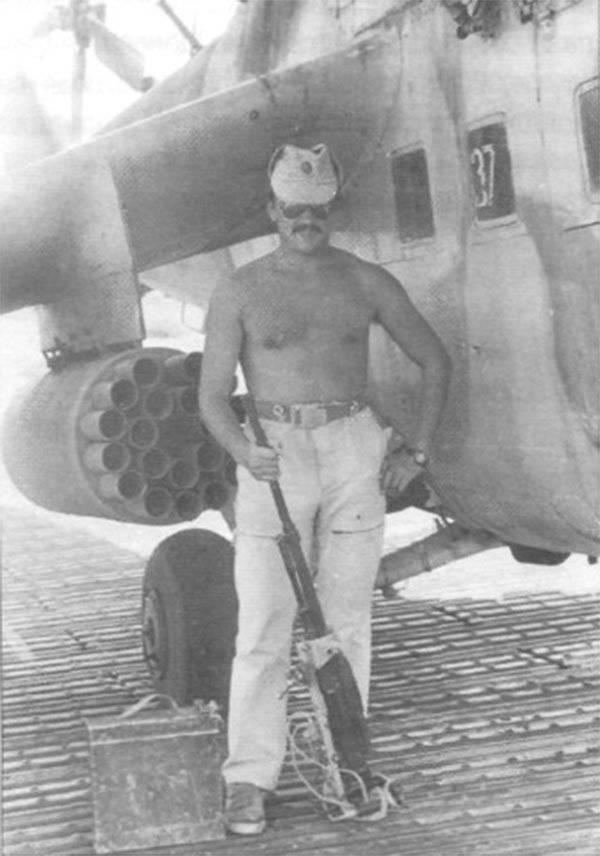
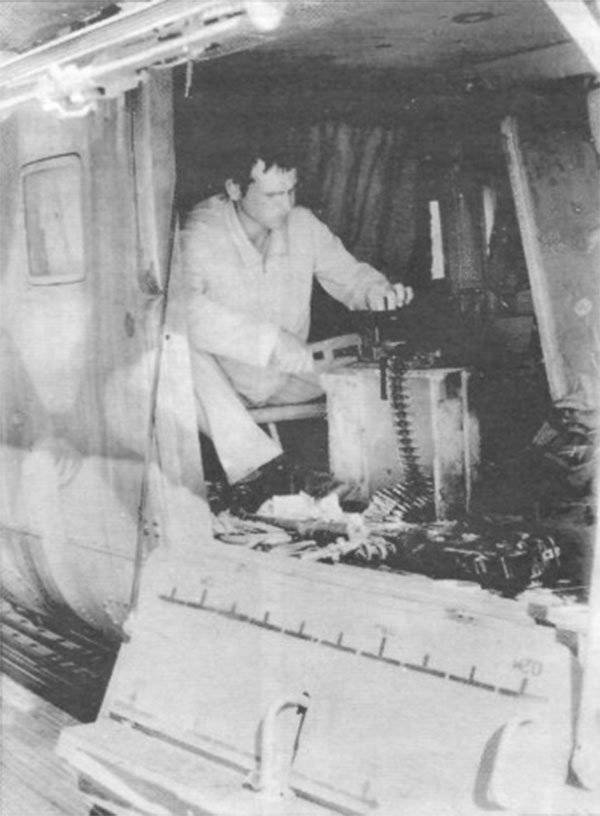
In the overall loss statistics of the Mi-24, more than half of the incidents had catastrophic consequences (with the death of the pilots), accounting for 52,5% of the total number, with almost two thirds of such cases (60,4% of the number of accidents) accompanied by the death of all crew members on board.
In order to prevent the loss of aircrews, at the end of January 1986 was ordered to fly a Mi-24 limited to two people crew of a pilot and an operator, leaving the flight engineer on the ground, without the benefit of pilots coping with duties. With regard to the effectiveness of his work as a shooter, unity was not observed: somewhere such a cover was considered necessary, while others, especially with the advent of MANPADS, considered him a whim and without a doubt called the onboard vehicle a "hostage". Truth in this was. The possibilities of covering the car at the “bortach” were really quite limited: it could fire only in the lateral directions, along the helicopter flight, while the most vulnerable rear hemisphere remained unprotected.
At the same time, in an emergency situation, if a vehicle was hit, the flight engineer’s chances of survival were much lower than those of a pilot and operator, whose workplaces were much better adapted for emergency leaving the helicopter and had the opportunity to “go” overboard from the seats. At the same time, the aertekhnik had to get out of its place in the narrow passage behind the commander’s seat, in the falling unmanaged car to get to the landing compartment casements and open them, trying not to hook the pylons and suspension blocks sticking in dangerous proximity under the wing when jumping with a parachute. As a result, non-unit cases were when the pilot and the operator managed to escape, and the flight engineer died while remaining in a falling car (in 50 OSAP at the end of 1984, in such situations, two flight engineers were killed in the downed Mi-24 in one week, though the rest of the crew remained alive). In the general statistics of losses, the loss of this category of flight personnel in the crews of the Mi-24 occurred more often than the pilots and operators. In the end, such cases had their effect, and the order to reduce the crew seemed quite reasonable. However, it was not observed everywhere, and often the flight equipment still flew in the crew. The Mi-24 frontier aviation, which had a different subordination, did not appear to have issued such an order, and their crews continued to rise into the air in full force, often also with additional shooters on board.
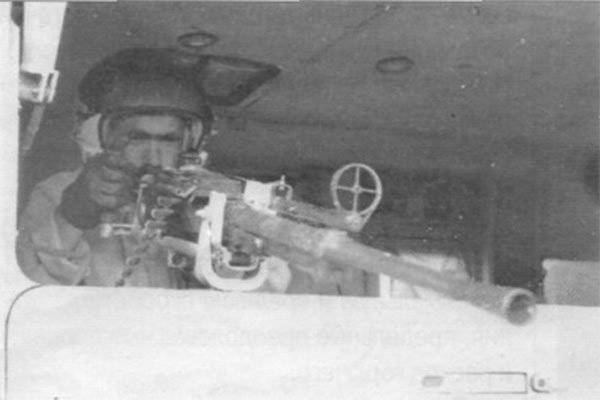
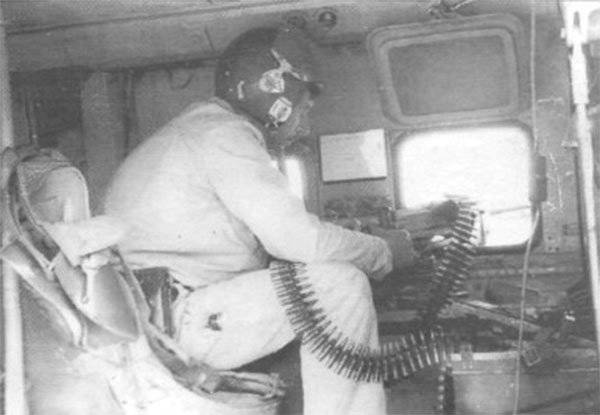
KB Mile also offered its own variant of the helicopter re-equipment. In 1985, instead of improvised rifle installations, in order to protect the Mi-24, a stern firing point was developed by testing it on the Mi-24В (serial number 353242111640). A large-caliber machine gun NSVT-12,7 "Rock" was installed on the helicopter, which allowed fighting on an equal footing with Dushman's DShKs. The rifle installation was equipped in the rear under the tail boom: it was open at the back, and on the sides it had ample glazing for viewing the rear hemisphere. Since the rear part of the helicopter’s fuselage was occupied by a lower fuel tank and racks with radio compartment equipment that prevented access to the shooter’s workplace, a similarity of a tunnel from a cargo cabin was built to the installation, and rubberized fabric “pants” hanging down the legs. Having taken a place, he found himself crooked in cramped under the overhanging blocks and equipment boxes, control cables and the shaft of the steering screw rotating overhead.
The construction turned out to be very cumbersome and inconvenient, besides, the review of the firing sector was also unsatisfactory. When showing the authorities a certain colonel from staff wanted to personally try out the novelty. Cabinet complexion led the chief - when trying to get to the machine gun, he was firmly stuck in a narrow aisle and had to be removed from there backwards. In addition to the layout flaws, the equipment of the “firing position” in the stern adversely affected the alignment of the helicopter with the ensuing consequences for maneuverability and controllability. Even after completion of the installation with the provision of access from the outside due to obvious flaws, it was declared unfit for use. In the order, the lack of protection in the rear was somewhat compensated by the completion with the installation of rear-view mirrors for the pilot, which were tested in the Mi-8 type, but mounted inside the cockpit, taking into account high flight speeds.
***
A story about the armament and work of helicopter aircraft in the Afghan war would be incomplete without mentioning the participation in the campaign of Kamov rotary-wing aircraft, which remained an almost unknown page in those events. It was by no means about testing in combat the new technology, which was the Ka-50 being worked out at that time: the machine that had just ascended into the sky with an unusual design and concept was then in its "childhood" age and it had problems with fine-tuning that did not allow make risky attempts to put her into battle. Nevertheless, from time to time, the Ka-27 and Ka-29 helicopters, already in service, appeared in Afghanistan. Besides fleetKama helicopters served in border aviation, being in demand in the border troops districts in mountainous regions, where their high power capacity, excellent load-bearing abilities, altitude and rate of climb, and resistance to the effects of ordinary winds in the mountains, tail and side winds were beneficial. The compactness of the coaxial machines (Kamov helicopters had a rotor of 16 meters diameter — one third less than the Mi-8 rotor) was not least suitable for the specifics of working in tight mountain conditions.
Kamov helicopters were in the Transcaucasian border district aviation, in particular, in the 12-th separate regiment, whose units were located in Georgia and Azerbaijan. The first squadron of the regiment at the airfield of Alekseyevka near Tbilisi had several Ka-27, in the second squadron, located in Kobuleti, there were two Ka-27 and two Ka-29. The crews of the regiment were constantly involved in work on Afghanistan on missions lasting 45 days, supporting and replacing fellow border guards from the Central Asian and Eastern districts. Kamov helicopters who occasionally worked in border areas participated in these tasks (according to stories, they happened to appear in Shindand), but the author does not have reliable information about their participation in hostilities.
This is not limited to story improve weapons during the "helicopter war" in Afghanistan. In addition to the appearance of new types and systems of weapons, the sighting equipment underwent changes, components and assemblies were subjected to modifications, their reliability and efficiency increased, defects were “caught”, and these hard work aimed at maintaining the proper level of machines accompanied it all the time.
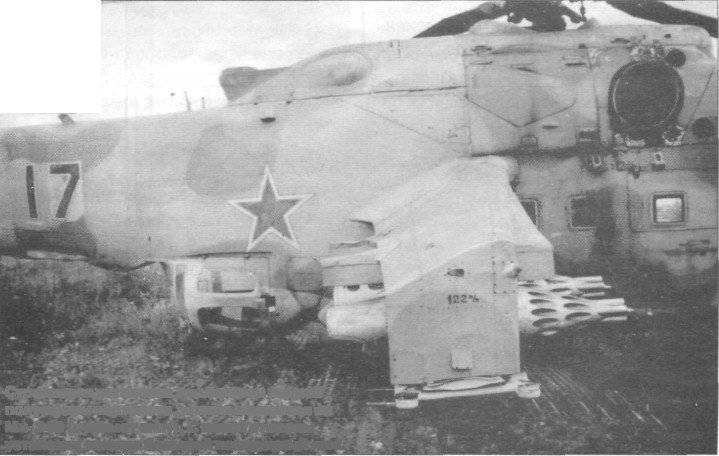
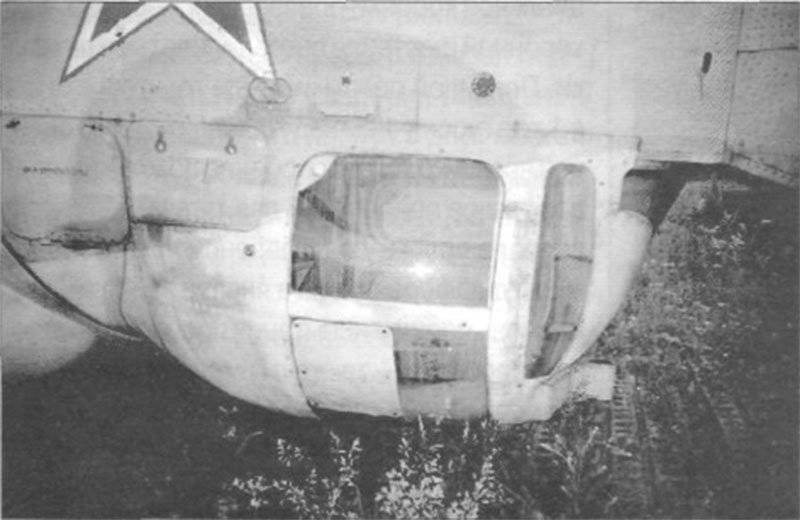
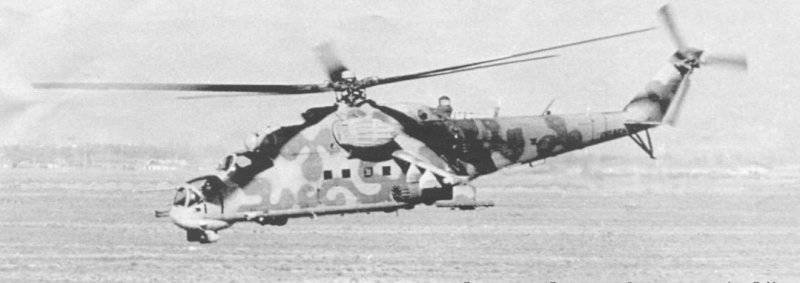

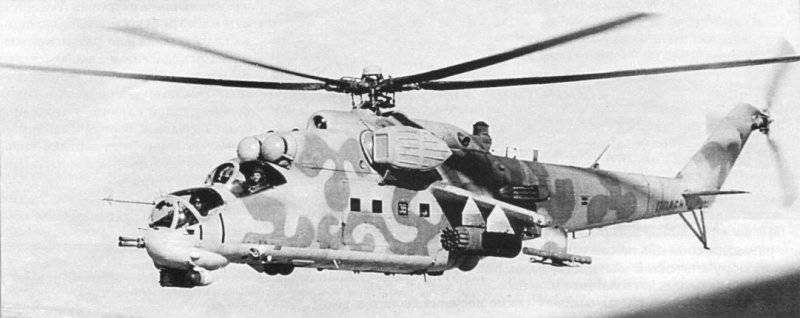
Information